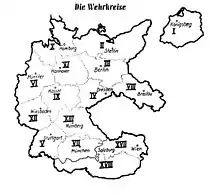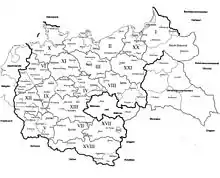Military district (Germany)
The military districts, also known in some English-language publications by their German name as Wehrkreise (singular: Wehrkreis),[1]: 27–40 were administrative territorial units in Nazi Germany before and during World War II. The task of military districts was the organization and the handling of reinforcements and resupplies for local military units. The Replacement Army (Ersatzheer) managed the districts. Responsibilities such as training, conscription, supply, and equipment were (at least partially) entrusted to the Ersatzheer.[2]: B2


History
On 30 September 1919, much of the Imperial German Army was dissolved. The Reichswehr (of the Weimar Republic) took its place, and four commands of the type Reichswehrgruppenkommando were created, as well as seven Wehrkreiskommando commands, each assigned to one of the seven initial Wehrkreise of the Weimar Republic (numbered I through VII).[3]: 145 The Reichswehrgruppenkommandos (which combined under them several military units across Wehrkreis lines) were soon reduced in number from four to two.[3]: 147
Each of the Wehrkreise was tasked to deploy one division by 1 October 1920 (resulting in the 1st through 7th Divisions of the Reichswehr, with the divisional ordinal number matching the cardinal number of the respective Wehrkreis). These seven (infantry) divisions were additionally joined by three cavalry divisions.[3]: 148
In peacetime, the 13 Wehrkreise were the home to the army corps of the same number and all subordinate units of that formation. The corps commander also commanded the Wehrkreis. Command of the Wehrkreis passed to the corps second-in-command at the outbreak of war.
At the start of the war, there were fifteen Districts in Germany. Two Austrian Districts had been added after the Anschluss of 1938. During the war, four were added, and some Districts had territory added to them from other countries conquered by Germany.
List of military districts
Wehrkreis I
Wehrkreis I was headquartered at Königsberg and contained the territory of the German exclave of East Prussia, making it also a coastal state on the Baltic Sea coast.[4]: 2 Wehrkreis I was the home district of the I Army Corps, which was formed in October 1934 from the 1st Division of the Reichswehr.[5]: 14 Wehrkreis I was expanded to include the Memel Territory after the German ultimatum to Lithuania (accepted by Lithuania on 23 March 1939);[1]: 32 the Wehrkreis was later fed yet more territory in the form of the Bialystok District and the Sudauen region.
Wehrkreis II
Wehrkreis II was headquartered at Stettin and included the territories of the historic provinces of Mecklenburg and Pomerania, which also gave Wehrkreis II the largest share of the German Baltic Sea coast.[4]: 59 Wehrkreis II was the home district of the II Army Corps, which was formed in October 1934 from the 2nd Division of the Reichswehr.[5]: 95
Wehrkreis III
Wehrkreis III was headquartered at Berlin and contained roughly the territories of the modern-day German state of Brandenburg and the historic province of Neumark.[4]: 113 Wehrkreis III was the home district of III Army Corps (after June 1942: III Panzer Corps), which was formed in October 1934 from the 3rd Division of the Reichswehr.[5]: 160f.
Wehrkreis IV
Wehrkreis IV was headquartered at Dresden and contained the territories of the modern-day German state of Saxony as well as some southern parts of modern-day Saxony-Anhalt.[4]: 187 Wehrkreis IV was the home district of IV Army Corps, which was formed in October 1934 from the 4th Division of the Reichswehr.[5]: 231 It was later expanded through the addition of parts of northern Bohemia after the Munich Agreement of 1938.[1]: 32
Wehrkreis V
Wehrkreis V was headquartered at Stuttgart, containing roughly the historic provinces of Baden, Württemberg, and Hohenzollern-Sigmaringen (about equivalent to the modern-day German state of Baden-Württemberg).[4]: 243 Wehrkreis V was the home district of V Army Corps, which was formed in October 1934 from the 5th Division of the Reichswehr.[5]: 231 After the German victory over France (1940), it was extended to include parts of Alsace.[1]: 32
Wehrkreis VI
Wehrkreis VI was headquartered at Münster and contained the historic province of Westphalia, much of the Lower Rhine, and parts of modern-day Lower Saxony.[4]: 291 Wehrkreis VI was the home district of VI Army Corps, which was formed in October 1934 from the 6th Division of the Reichswehr.[6]: 9f. After the German occupation of Belgium (1940), parts of eastern Belgium were added to Wehrkreis VI.[1]: 32
Wehrkreis VII
Wehrkreis VII was headquartered at Munich and contained the south of the modern-day German state of Bavaria.[7]: 2 Wehrkreis VII was the home district of VII Army Corps, which was formed in October 1934 from the 7th Division of the Reichswehr.[6]: 53
Wehrkreis VIII
Wehrkreis VIII was headquartered at Breslau and contained the territory of the historic province of Silesia.[7]: 51 Wehrkreis VIII was the home district of VIII Army Corps, which was formed in October 1934, initially disguised as "Heeresdienststelle Breslau". The corps was then given its proper designation as VIII Army Corps in 1935.[6]: 91f. After the Munich Agreement (1938), parts of northern Moravia were added to the district. After the German invasion of Poland (1939), the territory was further extended to include parts of East Upper Silesia.[1]: 32
Wehrkreis IX
Wehrkreis IX was headquartered at Kassel and contained territories in central Germany, including parts of modern-day Hesse and Thuringia.[7]: 126 Wehrkreis IX was the home district of the IX Army Corps, which was formed in October 1934, initially disguised as "Heeresdienststelle Kassel". The corps was then given its proper designation as IX Army Corps in 1935.[6]: 128f.
Wehrkreis X
Wehrkreis X was headquartered at Hamburg. It contained the territories of modern-day Schleswig-Holstein and most of the north of modern-day Lower Saxony, placing Wehrkreis X exclusively in charge of the German North Sea coast, as well as parts of the Baltic Sea coast.[7]: 179 Wehrkreis X was the home district of the X Army Corps, which was formed on 15 October 1935 from the Cavalry Corps.[6]: 163
Wehrkreis XI
Wehrkreis XI was headquartered at Hanover. It contained territories in northern-central Germany, including large parts of what in the modern day is southeastern Lower Saxony and northern Saxony-Anhalt.[7]: 234 Wehrkreis XI was the home district of the XI Army Corps, which was formed on 1 October 1936 with headquarters at Hanover.[6]: 194f.
Wehrkreis XII
Wehrkreis XII was headquartered at Wiesbaden. Its territory was roughly equivalent to the modern-day German states of Rhineland-Palatinate and Saarland, with the addition of a small part of northern Baden (around Heidelberg).[7]: 276 Wehrkreis XII was the home district of the XII Army Corps, which was formed on 1 October 1936 with headquarters at Wiesbaden.[6]: 230f. After the German victory over France (1940), Wehrkreis XII was expanded through the addition of parts of Lorraine (such as the Nancy area).[1]: 32
Wehrkreis XIII
Wehrkreis XIII was headquartered at Nuremberg. It contained the territories of the historic provinces of Franconia and Upper Palatinate in what is today the northern half of modern-day Bavaria.[7]: 319 Wehrkreis XIII was the home district of XIII Army Corps, which was formed on 1 October 1937 with headquarters at Nuremberg.[6]: 260 The district was expanded after the Munich Agreement (1938) to include parts of western Bohemia.[1]: 32
Wehrkreis XVII
Wehrkreis XVII was headquartered at Vienna. It contained the northeastern third of Austria, added to the German Reich after the 1938 Anschluss.[8]: 2 Wehrkreis XVII was the home district of XVII Army Corps, which was formed on 1 April 1938 with headquarters at Vienna.[9]: 54f. The district was expanded after the Munich Agreement (1938) to include parts of southern Bohemia.[1]: 32
Wehrkreis XVIII
Wehrkreis XVIII was headquartered at Salzburg. It contained the southwestern and southeastern thirds of Austria, added to the German Reich after the 1938 Anschluss. Wehrkreis XVIII was the home district of XVIII Army Corps (after 1940: XVIII Mountain Corps), which was formed on 1 April 1938 with headquarters in Salzburg.[9]: 40
Wehrkreis XX
Wehrkreis XX was headquartered at Danzig. It contained the historic province of West Prussia, occupied by Germany in the 1939 Invasion of Poland.[8]: 63
Wehrkreis XXI
Wehrkreis XXI was headquartered at Posen. It contained the territories of the historic region by the same name, occupied by Germany in the 1939 Invasion of Poland.[8]: 89
Protectorate Bohemia-Moravia
The Protectorate of Bohemia and Moravia was also a Wehrkreis,[8]: 114 with respective institutions being created in late 1942.[1]: 32
Generalgouvernement
The General Government was also a Wehrkreis,[8]: 143 with respective institutions being created in 1943.[1]: 32
Gaps in numbering
Several cardinal numbers were not assigned to a particular Wehrkreis and skipped in the numbering. These were 14 (XIV), 15 (XV), 16 (XVI) and 19 (XIX). As the Wehrkreis system was initially tightly bound to the army corps (with each of the thirteen original districts as well as the two Austrian district being assigned an army corps of the matching ordinal number with its headquarters in that Wehrkreis), these numbers were skipped as they were taken up by the motorized corps (XIV Army Corps, XV Army Corps, XVI Army Corps, XIX Army Corps). The four corps were not inherently bound to one particular military district (but naturally ended up with some connections to their respective peacetime headquarters regardless).
See also
References
- Mitcham, Samuel W. (1985). Hitler's Legions: The German Army Order of Battle, World War II. Stein and Days Publishing. ISBN 0812829921.
- Hogg, Ian V. (1975). German Order of Battle 1944: The Regiments, Formations and Units of the German Ground Forces London. London: Arms and Armour Press.
- Tessin, Georg (1974). Deutsche Verbände und Truppen 1918–1939 (in German). Biblio. ISBN 3764810009.
- Tessin, Georg (1996). Zweng, Christian (ed.). Verzeichnis der Friedensgarnisonen 1932–1939 und Stationierungen im Kriege 1939–1945. Wehrkreise I–VI. Verbände und Truppen der deutschen Wehrmacht und Waffen-SS im Zweiten Weltkrieg 1939-1945 (in German). Vol. 16. Osnabrück: Biblio Verlag. ISBN 3764817453.
- Tessin, Georg (1975). Die Landstreitkräfte 1–5. Verbände und Truppen der deutschen Wehrmacht und Waffen-SS im Zweiten Weltkrieg 1939-1945 (in German). Vol. 2. Osnabrück: Verlag E. S. Mittler & Sohn GmbH.
- Tessin, Georg (1977). Die Landstreitkräfte 6–14. Verbände und Truppen der deutschen Wehrmacht und Waffen-SS im Zweiten Weltkrieg 1939-1945 (in German). Vol. 3. Osnabrück: Verlag E. S. Mittler & Sohn GmbH.
- Tessin, Georg (1996). Zweng, Christian (ed.). Verzeichnis der Friedensgarnisonen 1932–1939 und Stationierungen im Kriege 1939–1945. Wehrkreise VII–XIII. Verbände und Truppen der deutschen Wehrmacht und Waffen-SS im Zweiten Weltkrieg 1939-1945 (in German). Vol. 17. Osnabrück: Biblio Verlag. ISBN 3764809418.
- Tessin, Georg (1996). Zweng, Christian (ed.). Verzeichnis der Friedensgarnisonen 1932–1939 und Stationierungen im Kriege 1939–1945: Wehrkreise XVII, XVIII, XX, XXI und besetzte Gebiete Ost und Südost. Verbände und Truppen der deutschen Wehrmacht und Waffen-SS im Zweiten Weltkrieg 1939-1945 (in German). Vol. 16. Osnabrück: Biblio Verlag. ISBN 3764809418.
- Tessin, Georg (1977). Die Landstreitkräfte 15–30. Verbände und Truppen der deutschen Wehrmacht und Waffen-SS im Zweiten Weltkrieg 1939-1945 (in German). Vol. 4. Osnabrück: Biblio Verlag. ISBN 3764810971.